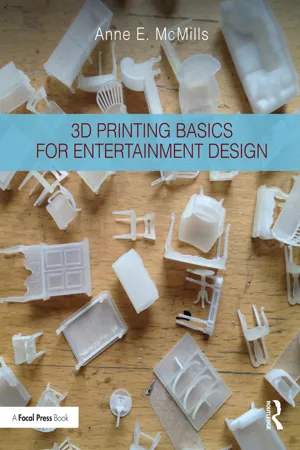
- 416 pages
- English
- ePUB (mobile friendly)
- Available on iOS & Android
3D Printing Basics for Entertainment Design
About this book
Affordable 3D printers are rapidly becoming everyday additions to the desktops and worktables of entertainment design practitioners – whether working in theatre, theme parks, television and film, museum design, window displays, animatronics, or… you name it! We are beginning to ask important questions about these emerging practices:
· How can we use 3D fabrication to make the design and production process more efficient?
· How can it be used to create useful and creative items?
· Can it save us from digging endlessly through thrift store shelves or from yet another late-night build?
· And when budgets are tight, will it save us money?
This quick start guide will help you navigate the alphabet soup that is 3D printing and begin to answer these questions for yourself. It outlines the basics of the technology, and its many uses in entertainment design. With straightforward and easy-to-follow information, you will learn ways to acquire printable 3D models, basic methods of creating your own, and tips along the way to produce successful prints.
Over 70 professionals contributed images, guidance, and never-before-seen case studies filled with insider secrets to this book, including tutorials by designer and pioneer, Owen M. Collins.
Frequently asked questions
- Essential is ideal for learners and professionals who enjoy exploring a wide range of subjects. Access the Essential Library with 800,000+ trusted titles and best-sellers across business, personal growth, and the humanities. Includes unlimited reading time and Standard Read Aloud voice.
- Complete: Perfect for advanced learners and researchers needing full, unrestricted access. Unlock 1.4M+ books across hundreds of subjects, including academic and specialized titles. The Complete Plan also includes advanced features like Premium Read Aloud and Research Assistant.
Please note we cannot support devices running on iOS 13 and Android 7 or earlier. Learn more about using the app.
Information
Part I
The Basics

So, What Exactly is 3D Printing?
- Rapid Prototyping (RP)
- Rapid Manufacture (RM)
- Rapid Tooling (RT)
- Additive Manufacturing (AM)
- Additive Layer Manufacture (ALM)
- 3D or Desktop Fabbing
- Direct Digital Fabrication
- Personal Manufacturing
- Desktop Manufacturing
- Digital Manufacturing
Chapter 1
Methods of 3D Printing
Printing Techniques

Fused Deposition Modeling (FDM)

- Fused Filament Fabrication (FFF)
- Molten Polymer Deposition (MPD)
- Thermoplastic Extrusion
- Fused Filament Method (FFM)
- Plastic Jet Printing (PJP)

Stereolithography (SLA)


- Optical Fabrication
- Photo-Solidification
- Solid Free-Form Fabrication
- Solid Imaging
Table of contents
- Cover
- Title
- Copyright
- Dedication
- Contents
- Acknowledgments
- Foreword
- Introduction
- PART I: The Basics
- PART II: Workflow
- PART III: The Entertainment Industry
- Appendices
- Endnotes
- Bibliography
- Index